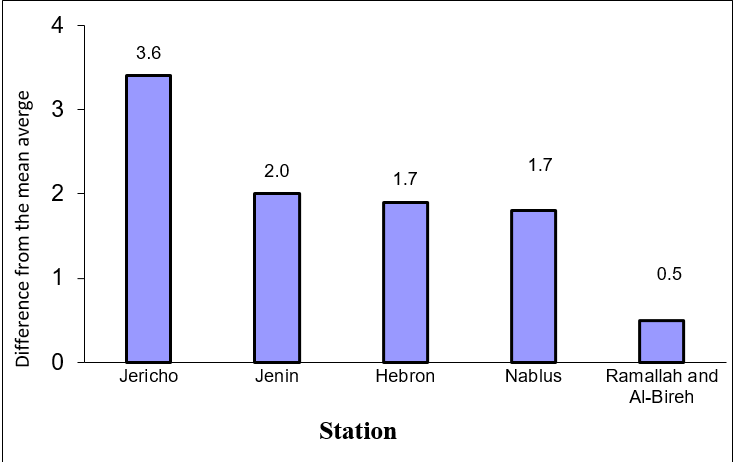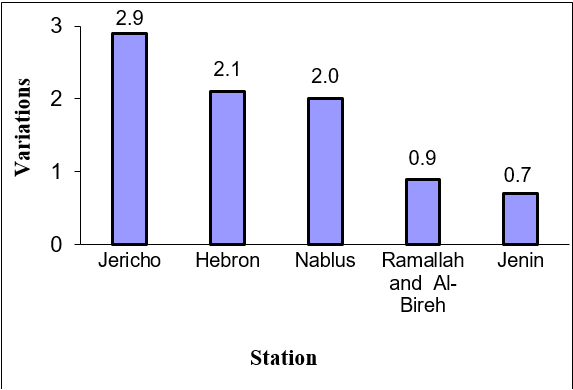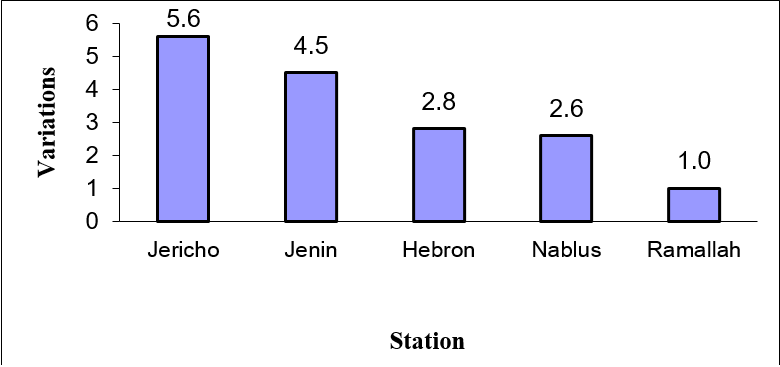The Palestinian Central Bureau of Statistics (PCBS) and the Palestinian Meteorological Directorate (PMD) jointly issued a press release on World Meteorological Day (WMD) under the theme "Closing the early warning gap together."
Every year on March 23rd, the World Meteorological Organization (WMO) celebrates World Meteorological Day. This year's theme is "Closing the early warning gap together".
The following are the most important features of the climate that prevailed during 2024:
Rain monitoring Station in Gaza Strip is Out of service after being destroyed during the Israeli aggression
Gaza Strip has (12) rain monitoring stations distributed from the north to the south. However, with the outbreak of the Israeli aggression on October 7th, 2023, all these stations were destroyed, resulting in the total loss of their data. Consequently, they will not be included in this report due to the unavailability of any recorded data.
Palestine and Early Warning
Early warning systems have become increasingly important to address unusual weather conditions that pose a risk to lives and property. Between 2021 and 2022, the Meteorology Department, in cooperation with several partners, implemented projects to enhance the technical and human infrastructure in the areas of early warning to serve various sectors, as (11) meteorological stations were installed, including two flood measurement stations, in addition to a forecast system that links the weather forecast center to international data sources and transmits warnings directly to the concerned authorities and citizens.
Currently, there is a project being implemented to enhance agricultural adaptation to climate change through the installation of (9) new monitoring stations and an early warning system, enabling farmers to be advised on weather hazards and their impact on crops.
Scarcity of rainfall during the rainy season
Based on the PMD data, the recent rainy season (2024/2025) until 02/03/2025 in the West Bank has been marked by low and scarce precipitate, due to the increasing of temperature and rain rarity. The northern and central parts of the West Bank received more rainfall than the southern areas, which were affected by weather depressions that were mostly concentrated in the northern and northwestern regions. Data showed that Salfit Station received the highest rainfall during the rainy season, totaling 332 mm, representing 48% of the mean average. On the other hand, Jericho Station received the lowest rainfall during the season, with only 54.8 mm, representing 33% of the mean average.
Cumulative Amounts of Rainfall Recorded at West Bank Stations from the Beginning of the Current Rain Season 2024/2025 till 02/03/2025 Compared with General Average by Station Location
|
Station Location |
Quantity of Rainfall till 02/03/2025 (mm) |
Mean Average (mm( |
% of Mean Average |
|
Salfit |
332.0 |
698.1 |
48 |
|
Nablus |
331.4 |
660.1 |
50 |
|
Qalqiliya |
331.0 |
624.9 |
53 |
|
Tulkarm |
289.9 |
602.4 |
48 |
|
Ramallah and Al-Bireh |
257.4 |
615.2 |
42 |
|
Hebron |
226.0 |
595.9 |
38 |
|
Jenin |
224.1 |
468.2 |
48 |
|
Tubas |
219.0 |
431.2 |
51 |
|
Jerusalem |
207.5 |
537 |
39 |
|
Bethlehem |
187.6 |
518.4 |
36 |
|
Jericho |
54.8 |
166 |
33 |
Highest humidity in Hebron, and the lowest in Jericho
In 2024, data showed that the relative humidity varied between 74% in Hebron Station and 44% in Jericho Station. It is important to note that high humidity levels do not necessarily indicate rainfall and could be in the form of other water phenomena such as fog, clouds touching the earth's surface, or dew formation.
Mean Relative Humidity (%) in 2024 and Mean Average in Some West Bank Stations
|
Station |
Relative Humidity (%), 2024 |
Mean Average % |
% of Mean Average |
|
Hebron |
74 |
62 |
119.4 |
|
Ramallah and Al-Bireh |
67 |
75 |
89.3 |
|
Jenin |
66 |
69 |
95.7 |
|
Nablus |
65 |
61 |
106.6 |
|
Jericho |
44 |
52 |
84.6 |
Total evaporation was higher than the mean average in 2024
Data showed that the total evaporation in the West Bank stations during 2024 was higher than the mean average. The majority of the stations recorded an increase in evaporation, with the highest amount of 2,811 mm observed in the Jericho Station and the lowest amount of 1,706 mm observed in the Nablus Station. It is worth noting that high temperatures and wind activity in the region influence the amount of evaporation.
Total Evaporation in 2024 and Mean Average of Evaporation in Some West Bank Stations
|
Station |
Total Evaporation (mm), 2024 |
Mean Average (mm) |
% of Mean Average |
|
Jericho |
2,811 |
2,101 |
133.8 |
|
Jenin |
1,971 |
.. |
.. |
|
Ramallah and Al-Bireh |
1,752 |
1,889 |
92.7 |
|
Nablus |
1,706 |
1,682 |
101.4 |
|
..: Data not Available |
|||
Air temperatures in 2024 are higher than the mean average
Air temperatures in the West Bank in 2024 were analyzed using data from selected stations representing the different climate zones. Including mountainous, semi-coastal and Al-Aghwar region. The results showed that the air temperatures in 2024 were higher than the mean average by 3.6°C in Jericho Station.
This significant increase in air temperatures can be attributed to heat waves that affected the West Bank during June, July and August. The mountainous, coastal, and semi-coastal areas were particularly affected, resulting in even higher temperatures in those locations. These heat waves were also accompanied by a marked increase in humidity levels in the same areas.
Variations in Air Temperatures (°C) from Mean Average at West Bank Stations
in 2024

During 2024, maximum temperatures varied across West Bank stations, showing notable variation, where Jenin Station witnessed a temperature increase of approximately 0.7°C higher than the mean average, while Jericho Station recorded a difference of 2.9°C.
Variations in Maximum Air Temperatures in 2024 (°C) from the Mean Average at West Bank Stations.

During 2024, minimum temperatures in Ramallah and Al-Bireh Station were higher than the mean average by around 1.0 °C, while in Jericho Station, they were higher by 5.6 °C.
Variations in Minimum Air Temperatures Compared to Mean Averages in Selected West Bank Stations in 2024.

The highest average hours of sunlight during 2024 was in Jericho Station
In 2024, Jericho Station experienced the highest average hours of sunlight, with 8.8 hours per day. On the other hand, Ramallah and Al-Bireh Station had the minimum average hours of sunlight with only 8.6 hours per day.
 عربي
عربي